Text
Arizona’s Race Relations and History of Gang Violence

America’s history with gang violence is complicated; it’s only been further muddied by Donald Trump’s presidency and the dystopian power of ICE (Immigration and Customs Enforcement). In states like Arizona, which have a diverse population of predominantly Hispanic and Caucasian communities, racial tensions have escalated since remarks by Trump claiming that Mexican immigrants were “drug dealers, rapists, and criminals.”. In Arizona, where 56% of the population is white, and 36% are Hispanic, race relations seemingly worsened during Trump’s presidency.
Recent news stories have only escalated the coverage and controversy regarding gang violence and crime in Arizona. In Scottsdale and Phoenix, MS-16 gang members were arrested after a DEA (Drug Enforcement Agency) raid uncovered ammunition, guns, and many illicit substances, such as fentanyl and cocaine. The narrative, however, that gangs have racial and socio-economic stereotypes is both outdated and offensive. In Phoenix and Tucson, especially in poorer communities on the city’s outskirts, police have targeted young street dealers - the most recent investigation led to nine arrested. Juvenile Probation Officer, Hellen Carter, says gangs originally existed to “protect the neighbourhood” but became a “cancer”.
When many cross-state arrests and gangs are young Hispanic men and women, there are questions about how these young people fall into lives of crime. Instead of disproportionally arresting young Hispanic people and turning a blind eye to the humanitarian atrocities happening in border states and Mexico, America should channel funds into drug and crime rehabilitation projects for young people rather than the racist incarceration complex.
5 notes
·
View notes
Text
Biden’s State of the Union: Everything But the State of the Union

State of the Union addresses are one of the most followed US political events, bar inaugurations and election night. Traditionally, the spectacle of the State of the Union is more followed and, notoriously, more publicised than the content of the speeches. The content of Joe Biden’s address was, much like his presidency thus far, forgettable and a smoke screen for the lack of political action undertaken by his administration. What dominated his speech were interruptions and heckling from Marjorie Taylor Greene (R-GA) and Lauren Boebart (R-CO), and the Ukraine Invasion.
Biden has become somewhat of a meme magnet, with a gaff that confused “Ukrainians with Iranians” and comparisons to Ukrainian President Zelenskyy’s address on the same day. An unconventional aspect of Biden’s speech was his praise of Ukrainian ambassador Oksana Markarova. Traditionally, Presidents have refrained from mentioning diplomats and conflicts such as Russia’s invasion of Ukraine. Markarova received a “warm hug” from FLOTUS Jill Biden and a standing ovation in the Senate. Similarly in the UK, Parliamentary Speaker Sir Lindsay Hoyle broke tradition by commending Ambassador Vadym Prystaiko, which also resulted in a standing ovation.
“A Tale of Two Presidents” is how Biden’s State of the Union address has been received. If the only thing taken away from his address is the GOP’s inappropriate heckling, then people are missing how crucial his support for Ukraine was during his speech. Breaking from tradition is not what Biden usually does, but it was what Ukraine, and America, needed.
3 notes
·
View notes
Text
“A Book Worth Banning is a Book Worth Reading”: The Fight Against Arizona’s Book Ban

What does The Tempest by Shakespeare, author Graham Swift, and graphic novel Maus by Art Spiegelman have in common? They’re currently facing a curriculum ban under new legislation proposed by Republican Representative Jake Hoffman of Arizona. House Bill 2495 states that “parental consent” is needed before a school or educational institution teaches material deemed “sexually explicit” or does not adhere to the criteria set out in the legislation. This criterion includes (although not limited to): masturbation, intercourse, genitalia, and, controversially, homosexuality.
Book banning has repeatedly caused a mass public outcry and has sparked national debates about who has the authority to ban a book. LGBTQ+ organisations, such as PEN America, have attacked the bill claiming that children and young adults would be pressured into coming out in requiring consent to read literature featuring “homosexuality”. Furthermore, in censoring depictions of homosexuality, Hoffman reinforces the offensive and outdated view that being gay is something to hide.

Arizona’s Ethnic Studies Ban deemed any book that depicted anarchy or discrimination to any particular race unauthorised to be taught. Hispanic communities in Arizona (31.9% of the total population) were targeted as historical biographies describing the Chicano/a movements in the twentieth century were seen as breaching the ban’s criteria.
“Me, poor man, my library was dukedom large enough,” claims Prospero in The Tempest. There isn’t a justification for book banning. Reading is the one thing that connects people. Humans love to rebel, almost as much as they love to read.
1 note
·
View note
Text
The Sackler Dynasty: Addiction, Opioids, and The Lucrative Business of Art Collecting
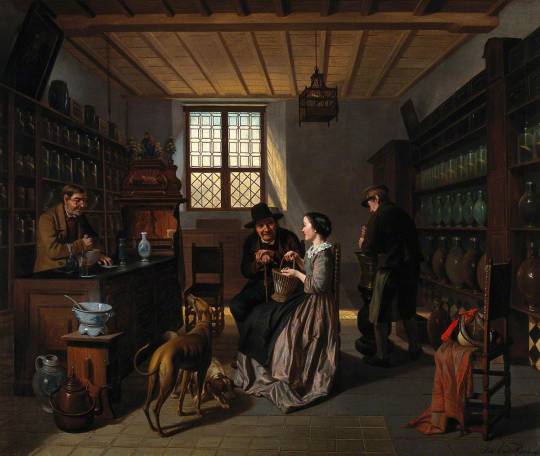
Interior of a Pharmacy, with Four Figures - Jos van Bree (c.1800-1860)
The opioid epidemic has crippled American families and communities across the US, resulting in over 500,000 drug-related deaths and counting. The story of the addictive drug OxyContin and its creators, Purdue Pharma (and by all accounts: The Sackler Family), is a shadowy tale of exploitation, crime, and a family dynasty so powerful it believed itself to be untouchable. The opioid epidemic unravelled the Sackler dynasty, posing the first real challenge to their empire whilst causing havoc in the world of art. The Sacklers, perceived as being equally pharmaceutical giants and patrons of the arts, balanced corruption with philanthropy. In decades where America prioritised foreign policy over domestic spending, are we really surprised that museums, such undervalued but appreciated aspects of society, are kept afloat by lucrative business deals and shady philanthropists?
While I initially set out to research why museums and cultural institutions accepted such lucrative donations from companies like Purdue Pharma (and by association the Sacklers), I soon realised I couldn’t ignore the hundreds of thousands of stories about corruption, addiction, and OxyContin. To examine this thoroughly, I had to fully understand the reach of the Sackler family and what made them so powerful. I had to also realise that underneath the controversy surrounding museums like The Met and the Guggenheim were families struggling to deal with addiction and lost loved ones. Whilst this is as much an article about the lucrative world of art collection and shady philanthropists, it is equally about the victims of the Sackler dynasty and of opioid addiction, who are fighting to be seen and longing for justice.

Arthur Sackler Sr.; with his brothers Mortimer and Raymond.
Let’s start at the beginning.
Arthur, Raymond and Mortimer Sackler were described as “The Modern Medici’s”. The trio cemented the Sackler family name in enterprises ranging from American pharmaceuticals and advertising in the early to mid-twentieth century, amassing a fortune that would place them on Forbes’ America’s Richest Families (even in 2020, they still rank at number 30). Whilst Arthur, the eldest of the three, secured business ventures and took on Madison Avenue’s top advertising firms, his brothers commandeered side projects and promoted the philanthropical face of the Sackler firm. Indeed, the brothers built an astounding business portfolio that, as author Patrick Radden Keefe explores in his book Empire of Pain: The Secret History of the Sackler Dynasty, featured recognisable names, such as Pfizer and Hoffman-La Roche.
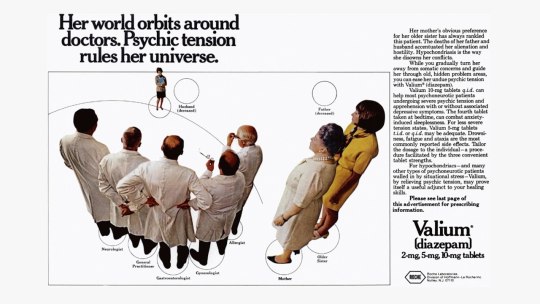
An Advert for Valium, created for Hoffman-La Roche. Released by A. Sackler's Advertising Firm, William Douglas McAdams
It was Arthur; however, that was the driving force behind the family enterprise. After just two years, Arthur secured the president position of prestigious advertising firm William Douglas McAdams. Apparently, his marketing ability would extend to every industry the Sackler’s touched. Creating what was described in an article in the New Yorker as “very serious, clinical” adverts for drugs and medicines, the Sackler brothers turned William Douglas McAdams into the ‘go-to’ agency for pharmaceutical companies. The determination to build and cement the Sackler name in the history books is one of Arthur Sackler’s most notable features. In Keefe’s book Empire of Pain, he notes how secret deals with competing advertising firms and FDA officials (Food and Drug Administration) secured the Sackler’s fortune. This is repeatedly questioned by those who encounter members of the Sackler family: how did they get rich?
The Sackler fortune had been amassed from drug advertising, specifically under-researched, over-hyped drug advertising. The controversy surrounding Valium, which saw some long-term users hospitalised and dependant on the tranquillizer, had been brushed under the carpet, much to the Sackler’s benefit. For Arthur, he spent any profit as quickly as it was earned. He had developed a borderline obsessive affection for Chinese and Asian art. As described by Keefe, his art obsession became so vast that he owned the most extensive private collection of Chinese art in the world. As journalist Christopher Glazek so poetically notes: “Addiction is a curse, be it drugs, women or collecting.” Like any addict, Arthur Sackler was always after his next fix. Serendipitously, he found it in the form of an Ancient Egyptian temple, which would serve as a small investment that would further fuel his art addiction.

The Temple of Dendur, Prior to Relocation to the Sackler Wing at The Metropolitan Museum of Art
The Temple of Dendur was originally located on the banks of the Nile. Built around 12BC, it had survived two World Wars, extreme heat, and the slow passing of time. When plans for a dam threatened the location of the archaeological site, the US donated millions as part of a ‘diplomatic’ exchange: America would fund the dam and Abdel el Sawy, an Egyptian official, would oversee the move of the Temple to the US. Former President Eisenhower oversaw efforts by The Guggenheim, Smithsonian, Museum of Natural History and The Met to acquire the Temple. Director of The Met, James Rorimer, hoped that a successful bid would solve two looming problems facing the museum: 1) secure funding to modernise the museum; 2) secure a historical art collection large enough to protect the financial future of the museum.
Fortunately for Rorimer, the Sackler brothers had a personal fortune large enough to impress Eisenhower with a proposed museum extension to house the Temple. “Innovative, showy, and a little bit shady”, Arthur Sackler’s negotiating skills secured a deal with The Met that ensured the Temple would be relocated to ‘The Sackler Wing’. It would also provide some personal benefits in exchange for what would later be described as a “gracious gesture.” The deal secured The Met $150,000 worth of funding. In return, Arthur would buy all the Asian art the museum had collected for the purchased price and then “re-gift” the collection under the pretence Sackler had actually donated the art. If that wasn’t enough, Arthur would also get private access to a secure storeroom for his personal art collection that only himself and his art advisor, Paul Singer, would be able to access.
Was The Met deal a happy coincidence or a scheme devised with larger vices at play? “Indeed, Arthur Sackler hardly stands alone as a rich person buying “indulgences””. A federal investigation drew blanks on the shady deal. Regardless, it was conducted ten years after the Temple was reconstructed. Was Rorimer stupid for accepting such a one-sided deal? Not exactly. His agreement with the Sackler’s ensured The Met’s financial security for the foreseeable future. The only unforeseen aspect was Rorimer’s untimely death. Arthur’s collection was rehoused at the Smithsonian in Washington DC. And until 2021, The Sackler’s name still hung over the door leading to the Temple of Dendur.
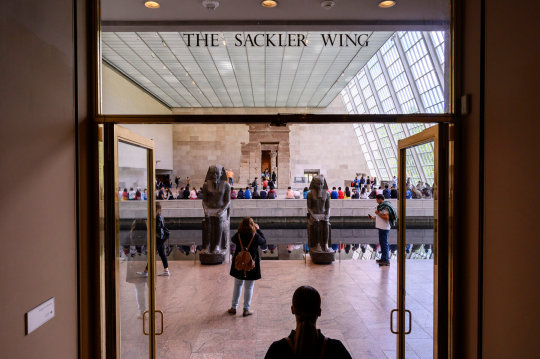
The Sackler Wing (prior to it’s name change) at The Metropolitan Museum of Art
Many of Sackler’s successes were derived from luck. Most notably (and perhaps, unfortunately) was the development of OxyContin. Beginning in the mid-90s (although Empire of Pain dates the creation of OxyContin as early as the late 80s), the painkiller was hailed as being revolutionary for curing chronic pain. A more potent form of the drug MS Contin (derived from the morphine family) OxyContin was recommended and prescribed for everything from joint and back pain to cancer treatments. Keefe details how one consultant was issuing up to 1000mg of OxyContin to their patients every day, an abundance so excessive it’s no wonder people became addicted. Having pitched the drug to the FDA and medical professionals as being no more addictive than MS Contin, despite being more potent and derived from oxycodone (a cousin of the street drug heroin), the Sackler’s geared up their efforts to falsely advertise deadly prescriptive drugs for profit. Bringing in over $1 billion worth of profit in its first few years on the market, Purdue Pharma’s advertising campaign ramped up OxyContin’s effectiveness.

The Sackler Center for Arts Education at The Guggenheim Museum, NY.
An increase in ‘generosity’ to the arts correlated with OxyContin’s economic success. The Guggenheim, home to the Sackler Centre for Arts Education’s, received approximately $7 million in “gifts’ from the Sackler’s between 1999 and 2006, on top of $2 million in additional donations. In 2019, artist Nan Goldin (a former opioid addict herself) held a protest at the Guggenheim for accepting donations from the Sackler’s through the late 90s and early 2000s. She also held a protest at the Sackler Wing in The Met, holding a ‘die-in’ and leaving hundreds of empty pill bottles in the fountain. “OxyContin: Prescribed to you by the Sacklers.” They were, as Keefe describes, “their own modest...little pieces of art.” And although both museums have stated they have not received any donations since the allegations emerged, it begs the question: why did they accept the donations in the first place?
One explanation is that in the 1990s, the NEA (National Endowment for the Arts) was at risk of being cut back and eliminated by conservative politicians who believed the organisation was funding artists, exhibitions, and museums that promoted leftists liberal messages. The organisation funded everything from art projects to exhibitions at well-known cultural education establishments. Eventually, the department was saved but museums suffered at the hands of conservative ideas and values. Exhibitions were boycotted for promoting Anti-American values (including the infamous flag burning by Dread Scott), which were only further spurred on by government officials supporting the censorship of such artwork. It seems almost contradictory that big pharmaceutical companies, a branch of the economy usually affiliated with conservative values and groups, were praised for stepping in and saving museums. Like their marketing strategies, Purdue had their philanthropic approach nailed to a tee. They could donate money to a good cause keeping the public on their side whilst pleasing Republican officials by aligning with their political-economic values.

Nan Goldin, “P.A.I.N. Protest at The Met’.
The ‘American Dream’ persona embodied by the original big three (Arthur, Mortimer and Raymond) seems more like a nightmare for the current generation of Sackler entrepreneurs. Any pretence of being the self-made children of immigrants has been drowned out by lawsuits and judgements ruling that they are undisputedly the creators and promoters of OxyContin. The road ahead is far from smooth for any party involved.
In 2020, it appeared a deal had been settled until a judge overturned it because the previous court had acted outside its remit concerning the proposed Bankruptcy Code Purdue Pharma had filed for. The deal included the Sackler family renouncing its ownership of the company, contributing $4.5 billion in cash and assets to a value of $10 billion, and the oversight of the creation of new anti-addiction medication development, in exchange for what would essentially be legal immunity from federal lawsuits. Importantly, they’d also promised not to lend their name to any museum for the next decade, claiming they’d “pass the torch” to others hoping to donate. The position it puts museums and galleries in to sort out the issue of donated money, gifts, and named rooms and galleries is especially problematic. Furthermore, as outlined in the same press release by a Sackler spokesperson, “the earliest of these gifts were made almost 30 years ago.” How do museums atone for such longstanding relationships with a family and corporation that’s always been controversial but has only recently been publicly vilified? And museums can’t actually return the money they’ve spent, so is any positive change purely ‘superficial’?
So, what are museums doing? For some, that is literally the million-dollar question. The Metropolitan Museum of Art in New York, the Louvre in Paris, and the Smithsonian are amongst some of the most prominent institutions in the art world who stated they will no longer accept donations from the Sackler family, with cries to keep the ‘Sackler’ name in rooms and wings at these cultural hubs, as a reminder of “human greed”. The Royal Academy elected to keep the Sackler name because it was from a different branch of the Sackler family. The divide emerging in the art world, highlighted by Nan Goldin’s protests and the indecisiveness to act on such donations, illustrates the problem museums and art houses find themselves in. The Royal Academy’s statement summarises the crux of the problem clearly: “The RA is an independent charity and does not receive government funding.”
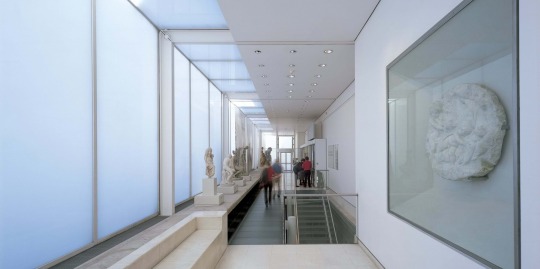
The Sackler Gallery at The Royal Academy of Arts, London
What the Sackler’s did was fundamentally wrong. There’s no other way to see it.
Over half a million Americans have died. And that’s just the ones recorded. More have turned to the use of hard drugs like heroin, lost their homes, jobs and loved ones to OxyContin (and by association, Fentanyl). And to that effect, it’s why I find it so difficult to justify the vilification of art establishments and museums. Politics and history have proven that more often than not, the austerity of governments causes museums to turn to billionaires and private funding. The struggle museums now face is accountability.
I recently visited The National Art Gallery in London, which has announced its rejection of a £1 million grant from the Sackler family. I remember seeing The Sackler Room embossed in gold around the covings of a long rectangular room, filled with Gainsborough paintings (some may even recognise the room from the acclaimed Bond film, Skyfall). The name held no significance to me then. And I’m sure much of the British public, who have witnessed only a handful of healthcare scandals over the past few decades, seeing a name like ‘Sackler’ embossed in gold on a wall is nothing more to them than another name in a story about a corrupt pharmaceutical company in America. I believe museums should keep any name or funding associated with the Sackler’s. Museums are responsible for educating the public about history, culture, and society. And by extension, all the good and evil that comes with it. In erasing this history, I fear there’s a risk of neglecting and forgetting the extent and abuse of power Purdue Pharma inflicted on millions of families and individuals. Handing the power of knowledge back into public hands prevents companies like Purdue Pharma from exploiting vulnerable individuals. Learning and remembering mean people don’t forget.
Financially, coming from an impoverished area and studying whilst a government continuously cuts funding to art education programmes and institutions has meant I deeply value museums and galleries. I understand the risks of history being erased, forgotten, or changed because an authority deems it irrelevant. Public funding should be used to maintain access to history because it’s our history. Museums serve the public; they help educate. It should be up to the government, a democratically elected institution that can be held accountable for its actions, to fund public initiatives like museums and galleries. Museums have a fundamental duty of care in telling history how it happened; I am not saying they should struggle financially by refusing private donations. Merely, museums and galleries should be transparent but thorough in who they accept help off. The Sackler’s are facing their day of judgement, and museums hold the power to show people that with time comes healing. History, art and everything that goes along with it belong to the public, not a wealthy minority.

The Sackler Room at The National Art Gallery, London
4 notes
·
View notes
Text
Land Of The Free (And The Tree): The Controversies Behind The White House Christmas Decorations

What could an average American buy with $140,000? Well, they could purchase a home in Buffalo, New York. Or they could buy four brand new Tesla Model 3′s, each priced at $35,000. For the President and First Lady of the United States, $140,000 can decorate the White House and the Eisenhower building.
The price tag of the 2021 White House Christmas decorations has earned Joe and Jill Biden harsh criticism about whether the cost of sprucing up the Presidential building for the festive season is worth it. The Covid-19 pandemic hit the US economy hard, resulting in the GDP dropping by 31.40% and unemployment rising to 14.7%. Many have viewed the lavish decorations as “tone deaf” and an attempt to distract the US public from the Biden administration’s mounting crises.

The comparison between Jill Biden and Melania Trump’s tree has also been a hot point of contention recently, with a “War on Christmas” being declared. The debate about who’s decorations are better have taken precedence over the actual meaning of Christmas and the spirit behind the decorations themselves. The politicisation of a “polite and safe” festive season embodies the true spirit of Christmas in the US White House.
5 notes
·
View notes
Text
“I’m for truth, no matter who tells it.” What the Exoneration of Malcom X’s Suspected Killers Says About the US Justice System
21 February 1965. Malcolm X walked onto the stage in the Audubon Ballroom to deliver a speech about black rights before being shot dead by masked gunmen. Flash forward to 19 November 2021, and two of the three convicted gunmen, Muhammad Aziz and Khalil Islam, have been exonerated for his murder.

This is definitely a historical milestone to celebrate. Still, the case of Malcolm X’s assassination proves that faults within the US justice system that consistently and repeatedly fails young, black men are still as prominent today as they were in the 1960s. The FBI ignored critical evidence, which was only recently uncovered after a 22-month investigation. This is another in a long list of criminal cases throughout US history where black men have been failed by the justice system.
The use of conspiracy theories and Netflix true crime documentaries have also been attributed to the outcome and verdict of this investigation, which begs the question as to why it requires entertainment giants and viewers to pave the road to justice for men wrongly accused of crimes. Profiting off the pain of wrongly accused black men is seen in the twenty-first century, with social media being used to promote fake activist pages in a #BLM era. In creating true crime documentaries on these stories for entertainment, no matter how historical they are, the system of justice in the US runs the risk of being undermined and proven to be ineffective and redundant in protecting the lives of black men.
7 notes
·
View notes
Text
The Haunting of Trump’s White House
“Things need not have happened to be true.” Neil Gaiman’s Sandman is not necessarily an obvious metaphor for the Republican party post-Trump. The story is about realising change is a good thing and distinguishing what is and isn’t real. To the dismay of many members of the GOP and American electorate, these aren’t things Trump can believe. Therefore, most of the GOP choose not to accept these things either. Businessman-turned-Virginian-Governor Glenn Youngkin is the hopeful Republican underdog who will change things.

“The only way the Republican party can go forward is...if we reject the efforts that President Trump made frankly to steal the election and if we tell voters the truth.” Liz Cheney, a former Wisconsin Representative, has repeatedly spoken out about how urgent it is for the Republican party to distance itself from Trump. Despite his promise to overturn Virginian law with controversial policies like banning critical race theory, many now view Youngkin as an extension of the ‘MAGA′ campaign due to Trump’s interference and success claims.
The election story of Youngkin, and the immortality of Trumpism, paints a bleak picture for the future of the Republican party. Youngkin’s fresh campaign strategy, which encouraged the electorate to vote early, compared with Trump’s stale complacency and controversial, violent rhetoric, shows the divide within the GOP and their struggle to mourn Trump, who haunts their politics. Any Republicans dreaming of a future without Trump are quickly realising this vision is devolving into a nightmare.

4 notes
·
View notes
Text
Colin Powell’s Legacy Will Outlive Us All

When people remember Colin Powell, they remember his presentation to the UN falsely alleging that Saddam Hussein was manufacturing and hoarding weapons of mass destruction in Iraq. He proved this by using a whiteboard, fabricated evidence, and a vial of ‘anthrax’. Until then, Powell had been the first Black Secretary of State, the second Black four-star general, and a wounded Vietnam veteran. On 5 February 2003, he added liar to that roster.

Powell is a brilliant contrast between how the UK and US media reflect on the war in Iraq that led to the deaths of millions. The UK has a history of blaming an individual rather than an institution for humanitarian crimes (cc: imperialism). Powell is considered to have “owned his mistakes”; his reputation as an advocate for civil rights is considered more significant. There are no real consequences for Powell, unlike former Prime Minister Tony Blair, who faced war crime trials and political defeats.
“What might have happened if, for once, Powell had refused to follow orders?”. This cynical question has an answer: millions of deaths prevented. Powell not only embodies America’s need to be ‘great again’; he also illustrates how the US military complex is built on lies and arrogance. American patriotism has created a failed state in Iraq and decimated the Middle East. This legacy has outlived Powell, and it will continue to cause further grief to Iraqi citizens well into the future.
9 notes
·
View notes
Text
“You’re toxic, I’m slippin’ under”: The Marriage Of Britney Spears And The Media
Throughout her career, Britney Spears has been called many things: child star, a pop phenomenon, “bald and broken”. The end of Spears’ 13-year conservatorship this year and the release of the documentary Framing Britney Spears has forced media outlets to revisit and apologise for how they reported on her public mental health crisis in 2007, which sparked a 14-year long fight for freedom.

The image of Britney shaving her head has been reproduced, and ‘meme-ified’ to such an extent where doing a “2007 Britney” is synonymous with shaving your head whilst experiencing a mental health crisis. Spears’ public battle against her conservatorship, although reaching a satisfying close for the #FreeBritney movement, has proved that the media is still pivotal and detrimental in her life. Whilst many viewed the #FreeBritney movement as liberating for the singer, which she thanked her fans for their support, this movement has again proven that Spears relied on the media to live her life.
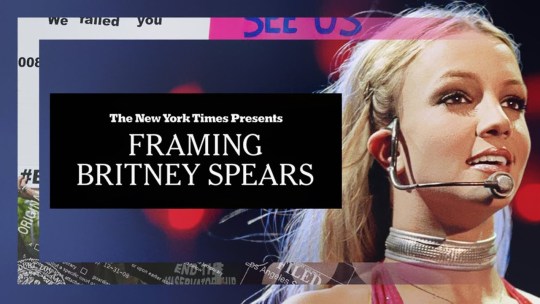
With Spears now liberated, questions about the future of conservatorships and their power over celebrities’ personal lives have arisen. Spears’ case is a tragic example of a woman trapped by her family, corrupted by the media, and having liberties stripped away from her, like the ability to have a family. Conversations surrounding mental health, feminism, and the power of the media have resulted in Britney finally being free, even if she’s had to rely on some of the institutions and journalists that trapped her there initially.
5 notes
·
View notes
Text
9/11 Twenty Years On: How America’s Censorship Efforts Contradict the Constitution

“Anyone who can blow up the Pentagon has my vote.” This was the joke of New Mexico University Professor Richard Berthold as the attacks on the Military headquarters were unfolding. Berthold was subsequently barred from teaching for a year. His defence for the comment? The First Amendment. As the article notes, Berthold was punished for voicing a politically motivated joke, which exemplified how justice systems favour certain political beliefs. Berthold’s joke was insensitive, yet it is often hard to judge and act on such a controversial issue without insulting different interpretations and opinions.
The New York Times reported that filmmaker Spike Lee removed 9/11 conspiracy theorists from his documentary, ‘NYC Epicenters 9/11-2021½’ after facing criticism for including them. As the article reports, Lee provided these individuals with a platform to voice their opinions equally, regardless of their claims’ lack of factual evidence. Like the 164 songs deemed inappropriate and banned from airwaves following the attack, individual interpretation can result in censored creativity and the removal of entrenched Constitutional freedoms, as detailed above.
America’s reactionary attitude to controversial events, like 9/11, has allowed dangerous political and conspiracy movements to emerge. By censoring specific demographics and ideas, America runs the risk of damaging the principles of its Constitution and providing a one-sided rather than a well-rounded view of controversial events. America has to learn that providing an outlet for diverse perspectives, regardless of controversy and insensitivity, can be a source of education: two things that are beneficial to every democratic society.
2 notes
·
View notes
Text
Learning Contract
Contemporary America in Context is a module designed to encourage me to branch out in the news outlets I engage with. I hope to achieve a more creative approach to history, politics, and sociological events, rather than academic styles of writing and investigation. Using facts, research, and personal opinions, I will debate stories and provide a different outlook on journalistic practices. I want to use my role as a student to engage in healthy discussions to widen my understanding of current and historical events.
I realise how different a blog is concerning academic assessment. By the end of the semester and the end of the academic year, I want to see a clear improvement in my writing, engaging with other blogs and a personal change in my open-mindedness. My aim and methods of achieving these goals are relatively straightforward: I would like to engage with news sources and stories I previously would not have. Finally, I will engage in debate and conversation with my course-mates blogs to understand how people similar to my own age understand these stories differently.
Debating is healthy, as is having different ideas. Society did not develop as a consequence of a single person with a single idea. In an age where politics and societal issues are becoming more partisan, I hope this module will force me to realise that a range of ideas can be a good thing. It will also highlight that not everybody in society can be as tolerant as I hope.
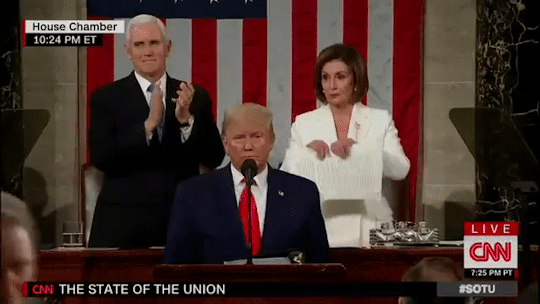
1 note
·
View note